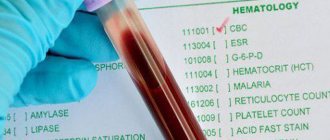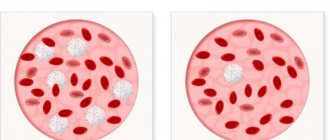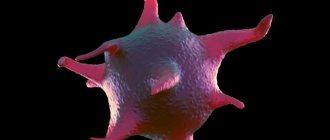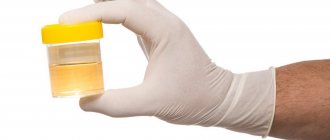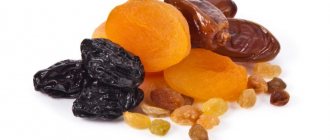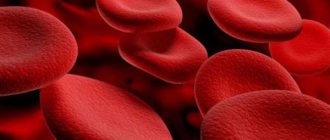Normal hemoglobin content in the blood
The high level of hemoglobin in the blood of a child at birth is due to the peculiarity of its intrauterine development, when the formation of tissues and body systems requires more oxygen and nutrition.
Hemoglobin indicators in newborns
The hemoglobin content in the blood of a newborn baby, from the moment of his birth to 1 month, changes and is expressed by the following values:
- newborn baby aged 1 – 2 days – 145 – 225 g/l;
- at the age of 3 – 7 days – 135 – 215 g/l;
- at the age of 8 – 14 days – 125 – 205 g/l;
- at the age of 15 – 30 days – 100 – 180 g/l.
Table of hemoglobin indicators depending on the age of the child
As the baby grows and develops, further formation of all body systems occurs. This process also affects the hemoglobin content in the baby’s blood, the quantitative change of which is determined depending on the child’s age in the following form:
- child age 2 months – 90 – 140 g/l;
- age 3 – 6 months – 95 – 135 g/l;
- from 6 to 12 months – 100 – 140 g/l;
- from 1 to 2 years – 105 – 145 g/l;
- from 3 to 6 years – 110 – 150 g/l;
- from 7 to 12 years – 115 – 150 g/l;
- from 13 to 15 years – 115 – 155 g/l;
- from 16 to 18 years – 120 – 160 g/l.
By the age of 18, the formation of a child’s body ends, and the hemoglobin content in the blood becomes equal to that of an adult.
How to understand
In order to understand whether hemoglobin is increased in children, whether it is low, or within the normal range, it is necessary to know the norm for a certain age of children.
For example, the level of protein in a newborn is normal, but the same amount of hemoglobin in a child at 3 years old or at 13 years old will far exceed the norm for hemoglobin in the blood.
The highest level of this protein in the blood occurs at the time of birth, and throughout the year it gradually decreases.
These indicators are considered the norm for the following ages:
- newborn – 240 g/l
- fifth day – 200 g/l
- tenth day – 190 g/l
As you can see, the indicators really decrease over time, and by the baby’s first year, the norm is 140 g/l.
A slightly overestimated indicator, as a rule, does not cause any suspicion to the doctor, but if the increased hemoglobin in children is 20-30 g more than normal, then in this case a more in-depth study of the baby is necessary.
Norms for hemoglobin content in blood
The level of hemoglobin in the blood varies depending on age and gender. At the same time, in childhood there is no difference in hemoglobin content between male and female sexes.
| Age and gender | Hemoglobin norms, g/l |
| Men | 130-170 |
| Women | 120-140 |
| Newborns | 180-240 |
| First week of life | 134-198 |
| From a week to a month | 107-171 |
| Per month | 100-180 |
| 2 months | 90-140 |
| 3-6 months | 95-135 |
| From 6 months to a year | 110-140 |
As can be seen from the table, hemoglobin in children under one year of age has different values, which is associated with the rapid growth of children and energy consumption for this process.
Hemoglobin in newborns has increased levels, since it was accumulated in utero, when the child received a sufficient amount of amino acids and iron from the mother. The decrease in hemoglobin is subsequently associated with its expenditure on the growth and development of the child. In this case, the source for the intake of components used for the synthesis of this protein is mother’s milk or formula. In this regard, the best nutrition is, of course, considered to be mother's milk, since by eating properly, she can compensate for the lack of amino acids and iron in the baby. Therefore, low hemoglobin in infants is usually observed when feeding with formula.
At 5-6 months, hemoglobin increases and normalizes due to the introduction of complementary foods, which compensate for the lack of necessary substances. And by the age of one year, the child’s biochemical mechanisms begin to work, thanks to which this protein is synthesized in the required volume.
It is necessary to take into account that for full-term infants and breast-fed children, the critical period, that is, the periods with the lowest hemoglobin levels, is 6 months, for premature infants and bottle-fed infants - 4-5 months.
Simultaneous increase in red blood cells and hemoglobin
The role of red blood cells in the life of the body is enormous. It is these small blood cells that saturate all cells with oxygen and amino acids, and also ensure the removal of carbon dioxide from them . They are inextricably linked with hemoglobin, and their norm for children can be considered to be in the range from 3.6 to 5.6x1012/l, it should be borne in mind that in newborns it is slightly higher, but gradually decreases with age. A simultaneous increase in hemoglobin and red blood cells in a child’s blood may indicate disturbances in blood circulation.
Signs
What signs may indicate increased hemoglobin in the blood?
- cyanosis of the skin, lips, fingertips;
- fatigue, lethargy, apathy;
- numbness of the limbs;
- dizziness;
- bruises appear constantly;
- poor appetite;
- increased blood pressure;
- thrombosis.
In addition, the child feels “out of place”, the mind is clouded, and problems with vision or hearing may occur.
Mothers also note that the baby constantly wants to sleep, becomes irritable and capricious, the skin is pale, and in some cases can become very red.
Of course, all these symptoms appear in advanced cases, but in the initial stages the child can feel good without complaining of poor health.
You ask: How can you then understand that the baby has increased hemoglobin? In the absence of symptoms, the only reliable result will be a blood test. The analysis should be carried out in the morning on an empty stomach, without exposing the baby to strong physical exertion.
Reduced hemoglobin levels
If a child, according to his age, has a persistent decrease in hemoglobin, this indicates problems with his health. The main task of the pediatrician is to find out the cause that led to a decrease in blood counts and eliminate it.
Reasons for low readings
Factors that influence the decrease in hemoglobin in a child can occur from both the mother and the baby. These are different reasons that contribute to low blood counts:
- maternal anemia during pregnancy caused by poor nutrition - insufficient consumption of fruits, vegetables and meat products rich in iron;
- blood loss in a child during childbirth - can develop with premature placental abruption or disruption of the integrity of the umbilical cord;
- prematurity of the baby;
- hemolytic jaundice of a newborn, developing due to incompatibility of the blood of mother and child according to blood group or Rh factor;
- intrauterine infections such as rubella, herpes or measles acquired by the mother during pregnancy;
- hereditary blood pathologies;
- uncontrolled long-term use of certain medications;
- helminthic infestations;
- allergic reactions to foreign compounds entering the body.
A decrease in hemoglobin in a child’s body requires mandatory treatment in order to prevent the development of complications during the baby’s growth. Low levels of protein in the blood can lead to a decrease in the body's defenses, as well as to a delay in physical and psycho-emotional development.
Children with low hemoglobin levels are often susceptible to various infectious and viral diseases, often taking a chronic course.
Increase in hemoglobin levels
Various diseases can cause a decrease in hemoglobin. Most often in children, a decrease in this indicator is caused by the development of anemia, when the body does not absorb enough iron. The reason for this phenomenon lies in the late introduction of complementary foods in babies or in unbalanced nutrition in older children.
In this case, it is necessary to adjust the baby’s diet by introducing foods rich in protein, iron, and B vitamins:
- lean beef, liver, chicken, turkey;
- buckwheat porridge;
- dried apricots, persimmons, pomegranates, apples;
- walnuts;
- chicken eggs;
- peas, beans.
Proper balanced nutrition in combination with taking iron supplements recommended by a specialist will help increase the child’s blood hemoglobin and improve his health.
Increased hemoglobin in children
Blood is the most important component in the human body and provides many vital processes. It has a complex structure and consists of many elements, the most important of which are hemoglobin, red blood cells and platelets . Different ages have their own characteristics of these blood elements, and their deviation from the norm may indicate the development of some pathology in a person.
Both hemoglobin and red blood cells with platelets should be regularly monitored by taking appropriate tests. All this fully applies to children, for whom there are normal indicators, deviation from which can lead to the development of serious diseases.
Causes
What reasons can lead to an increase in red blood cells in the blood?
The most common reason, according to doctors, is dehydration of the body, and as a result, thickening of the blood. By the way, it is also the safest. Why does dehydration occur? There are several reasons that lead to dehydration:
- insufficient fluid intake;
- increased dryness of the surrounding air;
- diarrhea;
- vomit;
- excessive physical activity;
- heavy sweating;
- heat;
- emotional overload,
- taking diuretic drinks.
This phenomenon can often occur in hot summers. In order to reduce hemoglobin levels, it is enough to simply increase the flow of fluid into the body.
Why is this dangerous?
It is logical to assume that viscous blood will be more difficult to flow through the vessels. Therefore, stagnation can form, leading to thrombosis. Agree that this is very serious, because it can threaten a small life.
Problems associated with intestinal obstruction can seriously affect the levels of iron protein in the blood. Therefore, before lowering its level, solve the problem of constipation.
This reason is quite serious and requires medical diagnosis and appropriate treatment.
With extensive burns, red blood cells demobilize all their forces to restore the affected tissue areas, so an increased level of hemoglobin is not considered a pathological condition.
If after the burns heal, the hemoglobin level does not drop, then you need to look for another reason.
Heart problems can cause an increase in iron protein levels. This is often observed with cor pulmonale.
Yes, imagine, as a result of a banal allergy, the level of hemoglobin can increase!
- Oncological diseases.
- Adrenal problems.
- Erythrocytosis.
What does it mean?
This disease is characterized by an increased content of red blood cells in the blood. Also quite common causes of increased hemoglobin levels in a child are participation in a sports section associated with physical overexertion. Therefore, if your child plays sports, there is no need to worry.
What could be the source
High hemoglobin in children's blood is very often associated with oversaturation of red blood cells or plasma, which is not in sufficient quantity.
Also, often high hemoglobin in a child indicates that the baby’s body has lost a lot of fluid, which caused thickening of the blood.
There are different reasons, but this is what pediatricians call the most common. It is caused by increased sweating, nerves, small amounts of fluids, staying in a room for a long time with dry and warm air, drinking tea, which increases diuretic properties, and fever.
There are reasons that are not dangerous if the protein level is too high:
- life in the mountains, city;
- great physical activity.
Pathological causes of elevated hemoglobin levels, in contrast to what should be, are:
- blood diseases;
- prolonged constipation (obstruction);
- kidney disease, during which excessive production of erythropoietin occurs;
- congenital heart diseases, pulmonary fibrosis. With such diseases, the production of red blood cells increases to restore oxygen balance;
- serious burn. If the blood is significantly affected, then the baby’s red blood cell production temporarily increases and hemoglobin in the blood increases.
This helps supply the necessary substances and oxygen to the affected tissue areas so that they heal faster;
- Vaquez-Osler disease, it has another name - erythmia or polycythemia. In this disease, the bone marrow produces a large number of blood cells, most of which are red blood cells.
This disease is more common in adults, but children can also get it, and it is much more difficult in children. The exact cause of this disease has not yet been determined.
The disease has the following symptoms: redness of areas of the skin and mucous membranes, veins dilate and swell, the skin itches, fingers hurt, constant fatigue, bleeding gums and other signs;
- other oncological pathologies.
In adolescence, an increase in hemoglobin is fraught with the use of tobacco products, stress, and the use of anabolic steroids when playing sports.
Consequences of decreased hemoglobin in the blood
Hemoglobin in infants is one of the most significant indicators, since the baby’s appetite, fatigue, sleep, and overall behavior and health depend on its level. It is better not to wait until the child develops anemia, but to take action at the first symptoms of this disease.
A decrease in hemoglobin in the blood can be noticed by the following signs: pale skin, fatigue, weakness, poor appetite, moodiness, brittle nails and hair, with a lack of vitamin B12, the tongue becomes bright red and looks painful. In addition, the baby experiences dizziness, tinnitus, shortness of breath, etc., which he cannot yet talk about. With low hemoglobin levels, the child's growth and development slow down.
If such signs appear in your baby, it is better to take a general blood test to find out the cause of poor health. If the results of the analysis confirm a low level of hemoglobin in the blood, then it is necessary to urgently take certain measures to increase it. If the indicators are normal, but are on the border, then it is necessary to carry out prophylaxis to increase the level of hemoglobin.
Diagnostics and normalization of the indicator
The condition is diagnosed by a complete blood test. The material is collected in the morning, always on an empty stomach. You must refrain from eating food for 8 hours before the test. Do not take medications or sweets before the procedure. Emotional outbursts and physical stress should be avoided.
To normalize the indicator, a special diet and drug therapy are prescribed. Usually, drugs are needed that affect blood viscosity by thinning it: Trental, Ticlopidine or Aspirin. Medications may be prescribed to normalize kidney function.
Nutrition for high Hb
The child's menu requires correction and exclusion of foods containing iron: liver, buckwheat, apples and pomegranates, juices from these fruits. It is necessary to remove nuts, dried fruits, beets, various sweets and fatty foods. Increase the amount of seafood and white meat chicken. You can introduce soy into your diet.
Be sure to increase fluid intake. The air in the child's room should be humidified. There are special devices for this. You can use a basin of water, but this method is less effective and takes longer.
Frequent ventilation of the room is important. The baby should take more walks and avoid excessive physical and emotional stress
In infancy, a decrease in Hb requires correction of the mother's diet.
Traditional methods
For older children, treatment with folk remedies is possible. Since sufficient drinking regimen is important for high hemoglobin, various herbal infusions and decoctions are administered. Chamomile, rose hips, and St. John's wort are good in this case. You can brew shepherd's purse and dandelion root. Use a mummy tablet dissolved in water as a drink.
Traditional medicine recommends treatment with leeches for elevated hemoglobin. The enzyme that their saliva contains reduces blood viscosity. Any folk remedies must be agreed with your doctor before use. When choosing herbs, you should consider possible allergic reactions.
High hemoglobin in a child’s blood is a condition that requires treatment. Life-threatening due to increased blood density. This can lead to blockage of blood vessels with blood clots. Diagnosis of the body is mandatory, since an increase in the indicator may be one of the symptoms of dangerous pathologies. The condition can affect a child's development, causing it to slow down. Plenty of drinking water, air humidity in the room, and regular walks are important. Diet and drug therapy are required. Medicines should be prescribed only by a pediatrician. To detect deviations early, you should undergo regular examinations and undergo tests in a timely manner.
Causes of increased hemoglobin content in the blood of a child
There are quite a few reasons for increased hemoglobin in children.
If the indicator really differs significantly from normal values, severe pathologies most likely occur:
- oncological neoplasms of various internal organs;
- congenital diseases and heart defects;
- heart and respiratory failure;
- intestinal obstruction;
- various blood pathologies.
In addition, thermal burns can significantly increase a baby’s hemoglobin level.
If we are talking about a school-age child, you should definitely pay attention to whether he gets enough rest. Increased hemoglobin can be observed in children who are too tired, both mentally and physically
In a newborn child, on the contrary, increased hemoglobin in the vast majority of cases does not indicate severe pathologies and diseases. While in the womb, the baby receives blood through her umbilical cord, as a result of which the hemoglobin concentration remains at a fairly high level. Normally, its indicators gradually decrease and by the time the baby is 2 weeks old, they reach a value of 140 grams per liter.
Of course, all of the above pathologies will affect not only the baby’s test results, but also his overall well-being. If your child additionally experiences symptoms of increased hemoglobin, such as excessive paleness or redness of the skin, constant drowsiness, and extreme fatigue, consult a doctor immediately.
If a child really has a severe pathology, its timely diagnosis will significantly increase the chances of successful treatment and protect the child from serious consequences. At the same time, if your child feels well, and the level of hemoglobin in his blood differs slightly from the norm, you should not worry too much, but you should monitor the levels at least once a year.
How to normalize the hemoglobin level in a child’s blood?
First of all, if you receive not very good test results, you should double-check them.
If, based on the results of repeated tests, significant deviations from the norm persist, you should immediately consult a doctor to conduct a detailed diagnosis and identify the true cause of the pathology.
A qualified doctor will be able to establish the correct diagnosis and prescribe appropriate treatment depending on the existing symptoms and general condition of the sick child.
If the hemoglobin level is slightly exceeded, the baby’s diet should be adjusted taking into account the following recommendations:
- completely eliminate from the diet or at least minimize the consumption of red meat, buckwheat, liver and other offal, as well as pomegranate;
- be sure to stop drinking natural pomegranate juice, but at the same time drink as much ordinary non-carbonated water as possible;
- add fish and seafood, chicken, legumes and soy to your daily menu.
Of course, there is no need to panic over every slight deviation in your son or daughter's test results. At the same time, the persistent increase in indicators should not be ignored.
Always remember that in the case of hemoglobin, a significant excess of the norm can have really serious reasons, so if you detect such signs, do not be too lazy to consult your doctor once again.
Simultaneous increase in hemoglobin and platelets in children
Another important component of blood are platelets, which are small, nuclear-free cells . For children, the indicator of this element should be in the range from 100 to 450 thousand units/μl, depending on age. Platelets, along with hemoglobin, are constituent elements of blood, and their simultaneous increase should alert the baby’s parents.
An increase in platelets, as a rule, leads to an increase in hemoglobin. This can happen if an infection enters the body or when an inflammatory process begins in the body . The increase in these indicators is also influenced by growing tumors, including oncological ones. An increase in platelets and hemoglobin in a child can also occur after taking certain medications, such as corticosteroids.
To make an accurate diagnosis, it is important for the doctor to take both of these indicators into account . As a rule, with a simultaneous increase in platelets and hemoglobin, blood thickening occurs, which is a consequence of dehydration. This pathological condition is dangerous because thrombocytosis can develop.
A child at any age should regularly visit a doctor and take a blood test to determine the level of hemoglobin, red blood cells, and platelets . If deviations in their indicators from the norm are detected in a timely manner and the necessary course of treatment is completed in time, then serious consequences in the future can be avoided. Parents should remember that there is nothing more important in life than the health of their baby.
source
Carrying out a hemoglobin test
A laboratory test for the content of hemoglobin in the blood is carried out in the first days of the child’s life in the maternity hospital, after discharge from which he is transferred under the supervision of a children’s consultation. In the future, a blood test for hemoglobin is prescribed by a pediatrician for certain indications.
Indications for analysis
A blood test can reveal the presence of health problems in the child, which are revealed during further examination:
- carrying out medical examinations on a healthy child's day;
- the presence of viral or bacterial infections;
- quality control of drug treatment for various diseases of the child;
- identification of congenital defects in the development of various body systems in children;
- before vaccinating children.
Analysis procedure
The blood collection procedure is not particularly difficult. There is also no need to specially prepare for this manipulation. The only mandatory condition for the test is donating blood on an empty stomach in the morning.
This rule does not apply to small children. The capriciousness and nervousness of a hungry child can give the wrong result. Since the quantitative norm of hemoglobin depends on the child’s age, the doctor must indicate it in the referral to the laboratory.
The procedure for determining hemoglobin in a child takes place in stages:
- the baby’s blood is taken from the network of capillaries of the ring finger or heel, after wiping the skin at the puncture site with an alcohol swab;
- With a sharp movement, an incision is made in the skin with a disposable scarifier and the blood is squeezed out. The first drop is removed with a dry cotton swab. Subsequent drops are used for analysis;
- blood is collected using a glass pipette to a certain level and placed in test tubes with the obligatory inscription of the child’s data;
- After taking the test, the incision site on the skin is lubricated with iodine and clamped with a tampon until the blood stops completely.
After conducting a blood test on the baby, the laboratory gives its conclusion on the quantitative content of hemoglobin. It can be normal, increased or decreased. If there is a deviation from the norm, the pediatrician determines the cause and prescribes treatment.
Hemoglobin norms
The value of the indicator in children depends more strongly on age than in adults. Its level in breastfed infants is influenced by the mother's diet. The highest concentration is in newborns; with growth it decreases significantly, almost 2 times. At the age of 5 years, Hb should not be more than 150 g/l. Average hemoglobin (Hb) values are shown in the table.
| Age | Hb, g/l |
| Up to 3 days of life | 145-225 |
| 1 week | 135-215 |
| 2 weeks | 125-205 |
| 1 month | 100-180 |
| 2 months | 90-140 |
| 3-6 months | 95-135 |
| 6-12 months | 100-140 |
| 1-3 years | 105-145 |
| 3-6 years | 110-150 |
| 7-12 years | 115-150 |
| 12-15 years | 118-155 |
A slight deviation is not a pathology. An increase in hemoglobin of 30 units in a child is considered dangerous. Under the influence of high Hb levels, the blood becomes thicker, which is fraught with thrombosis. In addition, other life-threatening diseases develop.
Symptoms of high hemoglobin in a child
Sometimes an increase in Hb is caused by a lack of fluid intake. In this case, classic symptoms may not be observed. Identifying the problem is difficult before reaching the age of 2-3 years, since young children cannot voice the ailments that bother them. Usually, when hemoglobin is higher than normal, babies become lethargic, drowsy, and lose weight. There are classic symptoms of increased hemoglobin in a child’s blood:
- poor appetite;
- headache;
- fatigue;
- loss of consciousness;
- bluish lips;
- change in skin color.
Please pay attention if your child:
- frequent hematomas form for no apparent reason;
- skin itching occurs;
- heart rate increases;
- there are bloody impurities in the stool;
- irritability appears, vision decreases, hearing deteriorates;
- bowel and urination disorders.
Reasons for increased Hb
The increase in hemoglobin may be associated with physiological characteristics. As a consequence of moisture deficiency, it can occur with heavy sweating, prolonged exposure to the sun, and low fluid intake. Diseases accompanied by increased body temperature are one of many causes. Burns also cause an increase in hemoglobin and red blood cells.
There are serious pathologies for which an increase in Hb is a sign: diseases of the cardiovascular system, kidneys, intestines, diabetes mellitus. Lung pathology and autoimmune diseases, oncology are the causes of high hemoglobin. The problem in infancy arises as a consequence of a difficult pregnancy, oxygen starvation of the fetus, and prematurity. In adolescence, stress and bad habits influence. Some medications increase Hb.
Important!
A child’s poor health, as well as the presence of several of the listed signs, is a reason for a detailed diagnosis. High hemoglobin can cause stroke and heart attack.

